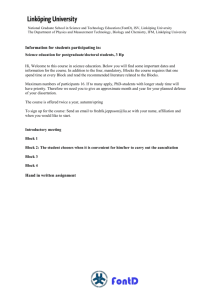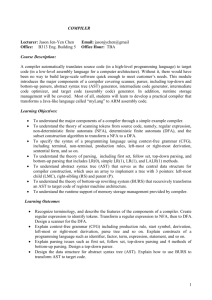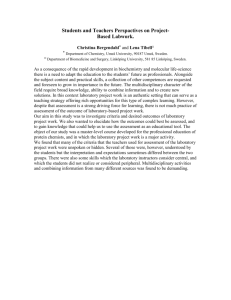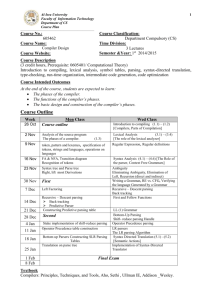Linköping University Dept. Computer and Information Science Autumn 03 COMPILER CONSTRUCTION
advertisement
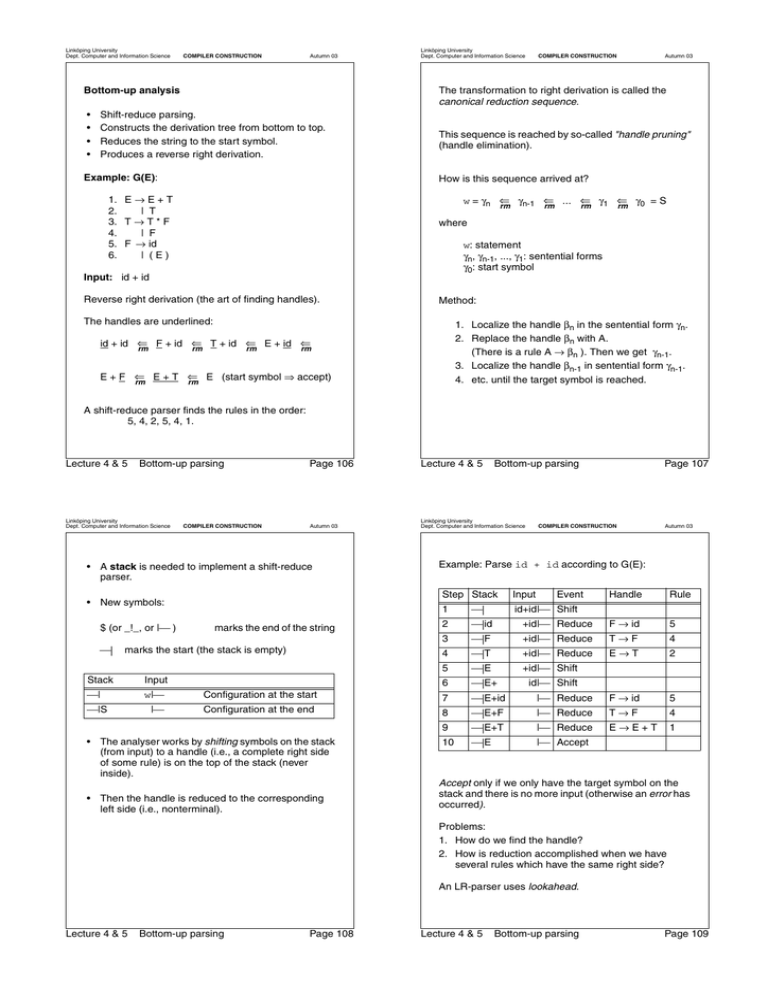
Linköping University
Dept. Computer and Information Science
COMPILER CONSTRUCTION
Autumn 03
Bottom-up analysis
•
•
•
•
Linköping University
Dept. Computer and Information Science
COMPILER CONSTRUCTION
Autumn 03
The transformation to right derivation is called the
canonical reduction sequence.
Shift-reduce parsing.
Constructs the derivation tree from bottom to top.
Reduces the string to the start symbol.
Produces a reverse right derivation.
Example: G(E):
This sequence is reached by so-called "handle pruning"
(handle elimination).
How is this sequence arrived at?
1. E → E + T
2.
| T
3. T → T * F
4.
| F
5. F → id
6.
| (E)
w = γn ⇐
γn-1 ⇐
... ⇐
γ1 ⇐
γ0 = S
rm
rm
rm
rm
where
w: statement
γn, γn-1, ..., γ1: sentential forms
γ0: start symbol
Input: id + id
Reverse right derivation (the art of finding handles).
Method:
The handles are underlined:
1. Localize the handle βn in the sentential form γn.
2. Replace the handle βn with A.
(There is a rule A → βn ). Then we get γn-1.
3. Localize the handle βn-1 in sentential form γn-1.
4. etc. until the target symbol is reached.
id + id ⇐
F + id ⇐
T + id ⇐
E + id ⇐
rm
rm
rm
rm
E+F ⇐
E+T ⇐
E (start symbol ⇒ accept)
rm
rm
A shift-reduce parser finds the rules in the order:
5, 4, 2, 5, 4, 1.
Lecture 4 & 5
Bottom-up parsing
Linköping University
Dept. Computer and Information Science
COMPILER CONSTRUCTION
Page 106
Lecture 4 & 5
Autumn 03
Linköping University
Dept. Computer and Information Science
• A stack is needed to implement a shift-reduce
parser.
|
marks the end of the string
marks the start (the stack is empty)
Page 107
COMPILER CONSTRUCTION
Autumn 03
Example: Parse id + id according to G(E):
Step Stack
• New symbols:
$ (or _!_, or | )
Bottom-up parsing
1
|
2
|id
Input
Event
Handle
Rule
F → id
5
id+id| Shift
+id| Reduce
3
|F
+id| Reduce
T→F
4
4
|T
+id| Reduce
E→T
2
5
|E
+id| Shift
id| Shift
Stack
Input
6
|
|E+
w|
Configuration at the start
7
|E+id
| Reduce
F → id
5
|
Configuration at the end
8
|E+F
| Reduce
T→F
4
9
|E+T
| Reduce
E→E+T
1
10
|E
| Accept
|S
• The analyser works by shifting symbols on the stack
(from input) to a handle (i.e., a complete right side
of some rule) is on the top of the stack (never
inside).
• Then the handle is reduced to the corresponding
left side (i.e., nonterminal).
Accept only if we only have the target symbol on the
stack and there is no more input (otherwise an error has
occurred).
Problems:
1. How do we find the handle?
2. How is reduction accomplished when we have
several rules which have the same right side?
An LR-parser uses lookahead.
Lecture 4 & 5
Bottom-up parsing
Page 108
Lecture 4 & 5
Bottom-up parsing
Page 109
Linköping University
Dept. Computer and Information Science
COMPILER CONSTRUCTION
Autumn 03
Linköping University
Dept. Computer and Information Science
COMPILER CONSTRUCTION
Autumn 03
LR-parser — Automatic construction
Augmented grammar (extended grammar)
Characteristics:
+ An LR analyser can analyze almost all languages
which can be described with a CFG.
Add a rule which includes the target symbol <S> and
the end symbol | (egentligen inte, men synlig-gör slutsymbolen)
+ More generally: Rewriting seldom needed,
left recursion, right recursion, several rules with the
same symbols at the beginning are not a problem.
+ As fast as hand-written.
+ Discovers the error as soon as it is possible.
- The semantics can not be introduced so easily.
- Difficult to generate by hand.
<SYS> → <S> |
Example of parsing using the LR method
(See the following pages for grammar and parse tables)
Input: a, b
Step Stack
LR classes
Input
Table entries
LR(0)
Too weak (no lookahead)
1
|0
SLR(1)
Simple LR, 1 token lookahead
2
|0a4
,b| ACTION[4, ,] = R3
LALR(1)
Most common, 1 token lookahead
|0E
,b| GOTO[0, E] = 6
LR(1)
1 token lookahead - tables far too big
|0E6
,b| ACTION[6, ,] = R2
LR(k)
k tokens lookahead
|0L
,b| GOTO[0, L] = 1
Example of table size:
Pascal: LALR(1) 20 pages, 2 bytes per entry.
Differences:
• Table size varies widely.
• Errors not discovered as quickly.
Limitations in the language definition.
Lecture 4 & 5
Bottom-up parsing
Linköping University
Dept. Computer and Information Science
COMPILER CONSTRUCTION
3
a,b| ACTION[0, a] = S4
(E → a)
(L → E)
4
|0L1
,b| ACTION[1, ,] = S2
5
|0L1,2
b| ACTION[2, b] = S5
6
|0L1,2b5
| ACTION[5, | ] = R4 (E → b)
|0L1,2E
| GOTO[2, E] = 3
7
8
|0L1,2E3
| ACTION[3, | ] = R1 (L→ L,E)
|0L
| GOTO[0, L] = 1
|0L1
| ACTION[1, | ] = A (accept)
Page 110
Lecture 4 & 5
Autumn 03
Linköping University
Dept. Computer and Information Science
T H E
Bottom-up parsing
Page 111
COMPILER CONSTRUCTION
P A R S E R
A C T I O N
Autumn 03
T A B L E
TOP OF STACK
Example of an SLR(1) grammar
T H E
V O C A B U L A R Y
T E R M I N A L S
1.
2.
3.
4.
N O N T E R M I N A L S
_!_
,
a
b
5.
6.
GOAL SYMBOL IS:
<list>
<element>
INPUT SYMBOL
-!- , a b
STATE
NAME
! 1 2 3 4
------------------------------!-----------0
<SYS>
! X X S4 S5
1
<list>
! A S2 * *
2
,
! X X S4 S5
3
<element>
! R1 R1 * *
4
a
! R3 R3 X X
5
b
! R4 R4 X X
6
<element>
! R2 R2 * *
T H E
<list>
G O T O
T A B L E
! (Note: The GOTO table is not the same as the GOTO graph, which
! represents both the ACTION table and the GOTO table)
T H E
TOP OF STACK
SYMBOL
<list><element>
STATE
NAME
! 5 6
------------------------------!-----0
<SYS>
! 1 6
1
<list>
! * *
2
,
! * 3
3
<element>
! * *
4
a
! * *
5
b
! * *
6
<element>
! * *
P R O D U C T I O N S
1.
2.
<list> ::= <list> , <element>
! <element>
3.
4.
<element> ::= a
! b
!
! NB: the following abbreviations are used in the tables above
!
!
X = error
!
!
* = impossible to end up here!
Lecture 4 & 5
Bottom-up parsing
Page 112
Lecture 4 & 5
Bottom-up parsing
Page 113
Linköping University
Dept. Computer and Information Science
COMPILER CONSTRUCTION
Autumn 03
Linköping University
Dept. Computer and Information Science
COMPILER CONSTRUCTION
L
L
E
E
Example.
Construction of a parse tree.
Construction of parse tree (Bottom-up)
• Shift operations:
Step 3
0
Step 2
0
a4
parse
Create a one-node tree containing the shifted
symbol.
stack
Autumn 03
L, E
E
a
b
E6
semantic
stack
• Reduce operations:
a
When reducing a handle β to A (as in A → β), create
a new node A whose ’’children’’ are those nodes
that were created in the handle.
Step 4
0
E
L1
During the analysis we have a forest of sub-trees. Each
entry in the stack points to its corresponding sub-tree.
When we accept, the whole parse tree is completed.
L
Step 8
0
Step 5 (cleaned up)
0
L1
L
,2
L1
,
L
L
E
E
,
E
b
a
a
Lecture 4 & 5
Bottom-up parsing
Linköping University
Dept. Computer and Information Science
COMPILER CONSTRUCTION
Page 114
Lecture 4 & 5
Bottom-up parsing
Autumn 03
Linköping University
Dept. Computer and Information Science
COMPILER CONSTRUCTION
Page 115
Autumn 03
Definition: LR-grammar:
Definition: Viable prefix
A grammar for which a unique LR-table can be
constructed is called an LR grammar (LR(0), SLR(1),
LALR(1), LR(1), ...).
The prefixes of a right sentential form which do not
contain any symbols to the right of a handle.
Example: (See next page for grammar and parse table)
• No ambiguous grammars are LR grammars.
• There are unambiguous grammars which are not
LR grammars.
• The state at the top of the stack contains all the
information we need.
1. <list> → <list> , <element>
2.
| <element>
3. <element> → a
4.
| b
Input: a, b, a
Right derivation (handles are underlined)
⇒ <list> , <element>
<list> rm
⇒ <list> , a
rm
⇒ <list> , <element> , a
rm
⇒ <list> , b , a
rm
⇒ <element> , b, a
rm
⇒ a , b, a
rm
Viable prefixes of the sentential form: <list> , b, a
are
{ ε, <list>, <list>,, <list>, b }
Lecture 4 & 5
Bottom-up parsing
Page 116
Lecture 4 & 5
Bottom-up parsing
Page 117
Linköping University
Dept. Computer and Information Science
COMPILER CONSTRUCTION
Autumn 03
A parser generator constructs a DFA which recognises
all viable prefixes.
This DFA is then transformed into table form.
Automatic construction of the ACTION- and GOTOtable:
Definition: LR(0) item
Linköping University
Dept. Computer and Information Science
COMPILER CONSTRUCTION
We want to construct a DFA which recognises all viable
prefixes of G(<SYS>):
Augmented grammar:
0. <SYS> → <list> |
1. <list> → <list> , <element>
2.
| <element>
3. <element> → a
4.
| b
start
<list>
0
,
1
2
<SYS> → <list> |
An LR(0) item of a rule P is a rule with a dot ’’•’’
somewhere in the right side.
3
<list> → <list> , <element>
6
<list> → <element>
1. <list> → <list> , <element>
are
a
a
4
<element> → a
<list> → • <list> , <element>
<list> → <list> • , <element>
<list> → <list> , • <element>
<list> → <list> , <element> •
b
b
5
<element> → b
Intuitively an item is interpreted as how much of the rule
we have found and how much remains.
Items are put together in sets which become the LR
analyser’s state.
Bottom-up parsing
Linköping University
Dept. Computer and Information Science
<element>
<element>
Example:
All LR(0) items of the production
Lecture 4 & 5
Autumn 03
COMPILER CONSTRUCTION
GOTO-graph
(A GOTO-graph is not the same as a GOTO-table but
corresponds to an ACTION + GOTO-table. The graph
discovers viable prefixes.)
Page 118
Lecture 4 & 5
Bottom-up parsing
Autumn 03
Linköping University
Dept. Computer and Information Science
Page 119
COMPILER CONSTRUCTION
Autumn 03
Algorithm to construct a GOTO-graph from the set
of LR(0)-items
(A detailed description is given in the textbook p. 221 ff)
0
<SYS> → • <list> |
<list> → • <list> , <element>
<list> → • <element>
<element> → • a
<element> → • b
Kernel (Basis)
Based on the canonical collection of LR(0) items draw
the GOTO graph.
The GOTO graph discovers those prefixes of right
sentential forms which have (at most) one handle
furthest to the right in the prefix.
Closure
(of kernel items)
GOTO graph with its LR(0) items:
Each set corresponds to a node in the GOTO graph.
When we have found the symbol behind ’’•’’ we move
the dot over the symbol.
start
1
<SYS> → <list> • |
<list> → <list> • , <element>
Kernel
(empty closure as ’’•’’ precedes terminals)
Closure
S
L
L
E
E
I0
→ •L |
→ •L , E
→ •E
→ •a
→ •b
L
E
I1
S → L • |
L → L• , E
I2
, L → L ,• E
E → •a
E → •b
I3
I6
L →E•
(shift-reduce conflict in the Kernel set!)
2
<list> → <list> , • <element>
Kernel
<element> → • a
<element> → • b
Closure
etc., (see the final result below).
Lecture 4 & 5
Bottom-up parsing
Page 120
Lecture 4 & 5
a
I4
E → a•
bb
I5
E → b•
Bottom-up parsing
a
b
Page 121
Linköping University
Dept. Computer and Information Science
COMPILER CONSTRUCTION
Autumn 03
Canonical collection of LR(0) items for the grammar
G(<SYS>)
I0
<SYS>
I1
I2
I3
→
•<list> |
Linköping University
Dept. Computer and Information Science
L R ( 0 )
STATENR.
S E T S
ITEMSET
O F
Autumn 03
I T E M S
SUCCESSOR
0
<SYS> --> .<list>
<list> --> .<list> , <element>
<list> --> .<element>
<element> --> .a
<element> --> .b
1
1
6
4
5
1
<SYS> --> <list> .
<list> --> <list> ., <element>
==>0
2
3
4
5
<list>
→
•<list> , <element>
<list>
→
•<element>
<element>
→
•a
<element>
→
•b
<SYS>
<list>
→
→
<list> • |
<list> •, <element>
2
<list> --> <list> , .<element>
<element> --> .a
<element> --> .b
<list>
→
<list> , • <element>
3
<list> --> <list> , <element> .
==>1
<element>
→
•a
4
<element> --> a .
==>3
<element>
→
•b
5
<element> --> b .
==>4
<list>
→
<list> , <element> •
6
<list> --> <element> .
==>2
I4
<element>
→
a•
I5
<element>
→
b•
I6
<list>
T H E
Lecture 4 & 5
COMPILER CONSTRUCTION
L O O K - A H E A D
NONTERMINAL SYMBOLS
→
<element> •
Bottom-up parsing
Linköping University
Dept. Computer and Information Science
COMPILER CONSTRUCTION
LOOK-AHEAD SET
<list>
_!_ ,
<element>
_!_ ,
Page 122
Lecture 4 & 5
Autumn 03
Linköping University
Dept. Computer and Information Science
Fill in the ACTION table according to the GOTO
graph
S E T S
Bottom-up parsing
COMPILER CONSTRUCTION
Page 123
Autumn 03
2. If there is a complete item
(i.e., ends in a dot ’’•’’):
<A> → α• ∈ Ii
Ii : state i (line i, itemset i)
Fill in reduce x where x is the production number for
1. If there is an item
x: <A> → α
<A> → α•aβ ∈ Ii
and
In which column(s) should reduce x be written?
GOTO(Ii , a) = Ij
a
LR(0) fills in for all input.
i
j
Ii
Ij
SLR(1) fills in for all input in FOLLOW(<A>).
LALR(1) fills in for all those that can follow a
certain instance of <A>
Fill in shift j for row i and column for symbol a.
3. If we have
ACTION:
<SYS> → <S> • |
a
accept the symbol |
i
Lecture 4 & 5
4. Otherwise error.
shift j
Bottom-up parsing
Page 124
Lecture 4 & 5
Bottom-up parsing
Page 125
Linköping University
Dept. Computer and Information Science
COMPILER CONSTRUCTION
Autumn 03
Linköping University
Dept. Computer and Information Science
COMPILER CONSTRUCTION
Fill in the GOTO table
Limitations of LR grammars
<A> → α• ∈ Ii
• No ambiguous grammar is LR(k)
If
the GOTO graph(Ii , <A>) = Ij
fill in
Autumn 03
• Shift-Reduce conflict
GOTO[ i, <A>] = j
• Reduce-Reduce conflict
GOTO:
What is a conflict?
<A>
i
Given the current state and input symbol it is not
possible to select an action (there are two or more
entries in the action table).
j
Example. Reduce/Reduce-conflict
procid → ident
exp → ident
Example. Shift/Reduce-conflict
if ... then ....
Stack top
Lecture 4 & 5
Bottom-up parsing
Linköping University
Dept. Computer and Information Science
COMPILER CONSTRUCTION
Page 126
Lecture 4 & 5
Autumn 03
Linköping University
Dept. Computer and Information Science
else
Next token
Bottom-up parsing
COMPILER CONSTRUCTION
Page 127
Autumn 03
dp
Example of Reduce/Reduce conflict:
Conflict elimination by
X
X→ (A)(B)
• factorising
A→ REAL INTEGER IDENT
( A )
• expansion
B → BOOL CHAR IDENT
Factorised grammar:
X
X→ (A)(B)(C)
A→ REAL INTEGER
• rewriting
IDENT
( B )
B → BOOL CHAR
IDENT
C → IDENT
Example of Shift/Reduce conflict: (One token lookahead: ( )
X → ( A ) OPT_Y ( B )
X
OPT_Y → ε Y
Y → ...
A → ...
B → ...
( A )
X
Expanded grammar:
X → ( A ) ( B ) Y ( B )
Y → ...
Lecture 4 & 5
A → ...
B → ...
Bottom-up parsing
OPT_Y ( B )
ε
Page 128
Lecture 4 & 5
Bottom-up parsing
Page 129
Linköping University
Dept. Computer and Information Science
COMPILER CONSTRUCTION
Autumn 03
A concrete example from the book pp. 174, 175:
rewriting
stmt
E1
then
if
Autumn 03
stmt → matched_stmt
unmatched_stmt
Ambiguous grammar, as the following statement has
two parse trees:
-alt 2
if E1 then if E2 then S1 else S2
-alt 1
expr
COMPILER CONSTRUCTION
Rewriting the grammar
stmt → if expr then stmt
if expr then stmt else stmt
other
if
Linköping University
Dept. Computer and Information Science
matched_stmt →
if expr then matched_stmt else matched_stmt
other
unmatched_stmt →
if expr then stmt
if expr then matched_stmt else unmatched_stmt
stmt
expr
then
stmt
else
S1
E2
stmt
This grammar will create the first alternative of parse
tree, i.e. try to match immediately if possible.
S2
stmt
if
expr
E1
then stmt else
if
expr
then
stmt
stmt S2
E2
Lecture 4 & 5
S1
Bottom-up parsing
Linköping University
Dept. Computer and Information Science
COMPILER CONSTRUCTION
Page 130
Lecture 4 & 5
Bottom-up parsing
Autumn 03
Linköping University
Dept. Computer and Information Science
Page 131
COMPILER CONSTRUCTION
Autumn 03
Shift-Reduce conflict
If both criterion (1) and (2) hold for a certain
item-set:
An LALR(1) grammar
<A> → α •
<B> → γ • aβ
run through the SLR(1) generator
Many conflicts are resolved in SLR(1) and LALR(1) by
using lookahead. These methods construct FOLLOWsets, e.g.:
FOLLOW(<list>) = { ’’|’’, ’’,’’ }
T H E
V O C A B U L A R Y
T E R M I N A L S
This set specifies terminal symbols which can follow the
nonterminal <list> during derivation, also called the
lookahead-set.
All SLR(1) grammars are unambiguous but there are
unambiguous grammars which are not SLR(1). The
same is true for LR(k). For LR(k) the intersection of the
lookahead sets must also be non-empty.
1.
2.
3.
4.
5.
6.
_!_
B
C
A
E
D
7.
8.
GOAL SYMBOL IS:
T H E
Reduce-Reduce conflict
If there are several complete items in an item-set, e.g.
1. <A> → α •
2. <B> → β α•
Lecture 4 & 5
N O N T E R M I N A L S
<S>
<A>
<S>
P R O D U C T I O N S
1.
2.
3.
<S> ::= B <A> C
! A E C
! A <A> D
4.
<A> ::= E
(reduce 1)
(reduce 2)
Bottom-up parsing
Page 132
Lecture 4 & 5
Bottom-up parsing
Page 133
Linköping University
Dept. Computer and Information Science
COMPILER CONSTRUCTION
L R ( 0 ) S E T S O F
STATENR.
ITEMSET
0
<SYS> --> .<S>
<S> --> .B <A> C
<S> --> .A E C
<S> --> .A <A> D
1
<SYS> --> <S> .
2
Autumn 03
I T E M S
SUCCESSOR
1
2
6
6
==>0
<S> --> B .<A> C
<A> --> .E
3
5
3
<S> --> B <A> .C
4
<S> --> B <A> C .
==>1
5
6
<A>
<S>
<S>
<A>
==>4
7
9
7
-->
-->
-->
-->
Linköping University
Dept. Computer and Information Science
run through the LALR(1) generator
T H E
V O C A B U L A R Y
T E R M I N A L S
1.
2.
3.
4.
5.
6.
<A> --> E .
<S> --> A E .C
==>4
8
8
<S> --> A E C .
9
<S> --> A <A> .D
10
<S> --> A <A> D .
N O N T E R M I N A L S
_!_
b
c
a
e
d
7.
8.
Goal symbol is:
<s>
<a>
<s>
T H E
7
Autumn 03
An LALR(1) grammar
4
E .
A .E C
A .<A> D
.E
COMPILER CONSTRUCTION
P R O D U C T I O N S
==>2
1.
2.
3.
<s> ::= b <a> c
! a e c
! a <a> d
10
4.
<a> ::= e
==>3
T H E L O O K - A H E A D
S E T S
NONTERMINAL SYMBOLS
LOOK-AHEAD SET
<S>
_!_
<A>
C D
****** SHIFT-REDUCE CONFLICT IN STATE
PRODUCTIONS:
2
4
7
THIS GRAMMAR IS NOT SLR(1)
Lecture 4 & 5
Bottom-up parsing
Linköping University
Dept. Computer and Information Science
L R ( 0 )
statenr.
0
COMPILER CONSTRUCTION
S E T S
O F
itemset
<SYS> --> .<s>
<s> --> .b <a> c
<s> --> .a e c
<s> --> .a <a> d
Page 134
Lecture 4 & 5
Autumn 03
Linköping University
Dept. Computer and Information Science
I T E M S
STATE
successor
1
2
6
6
1
<SYS> --> <s> .
==>0
2
<s> --> b .<a> c
<a> --> .e
3
5
3
<s> --> b <a> .c
4
4
<s> --> b <a> c .
==>1
5
<a> --> e .
==>4
6
<s> --> a .e c
<s> --> a .<a> d
<a> --> .e
7
9
7
7
<a> --> e .
<s> --> a e .c
==>4
8
8
<s> --> a e c .
==>2
9
<s> --> a <a> .d
10
<s> --> a <a> d .
10
==>3
Bottom-up parsing
Page 135
COMPILER CONSTRUCTION
Autumn 03
T H E L O O K - A H E A D
S E T S
PRODUCTION
LOOK-AHEAD SET
1
4
5
7
8
10
0
1
4
4
2
3
_!_
_!_
_!_
d
_!_
_!_
b c a e d
b c a e d
b c a e d
b c a e d
T H E P A R S E R A C T I O N T A B L E
TOP OF STACK
INPUT SYMBOL
STATE
NAME
! 1 2 3 4 5 6
----------------------------!---------------0
<SYS>
! X S2 X S6 X X
1
<s>
! A X X X X X
2
b
! X X X X -4 X
3
<a>
! X X -1 X X X
6
a
! X X X X S7 X
7
e
! X X -2 X X R4
9
<a>
! * * * * * -3
T H E G O T O T A B L E
TOP OF STACK
SYMBOL
STATE
NAME
! 7 8
-------------------------!-----0
<SYS>
! 1 *
1
<s>
! * *
2
b
! * 3
3
<a>
! * *
6
a
! * 9
7
e
! * *
9
<a>
! * *
NB: The tables are optimised.
For example, -4 in the action table stands for
shift-reduce according to rule 4.
Lecture 4 & 5
Bottom-up parsing
Page 136
Lecture 4 & 5
Bottom-up parsing
Page 137
Linköping University
Dept. Computer and Information Science
COMPILER CONSTRUCTION
Autumn 03
Methods for syntax error management
Linköping University
Dept. Computer and Information Science
COMPILER CONSTRUCTION
Autumn 03
1. Panic mode
c) Skip input until either
1. Panic mode
i)
2. Coding of wrong entries in the ACTION table
Parsing can continue, or
ii) An important symbol has been found
(e.g. PROCEDURE, BEGIN, WHILE,...)
3. Wrong productions
d) If parsing can not continue:
4. Language-independent methods:
4a) Continuation method, Röchrich (1980)
Pop the stack until the important symbol is
accepted.
4b) Automatic error recovery, Burke & Fisher
(1982)
If you reach the bottom of the stack:
"Quit --Unrecoverable error."
- Much input can be removed.
- Semantic info on the stack disappears.
+ Systematic, simple to implement.
+ Efficient, very fast and does not require extra
memory.
(The other methods are dealt with later in the section on
error management.)
Lecture 4 & 5
Bottom-up parsing
Page 138
Lecture 4 & 5
Bottom-up parsing
Page 139
